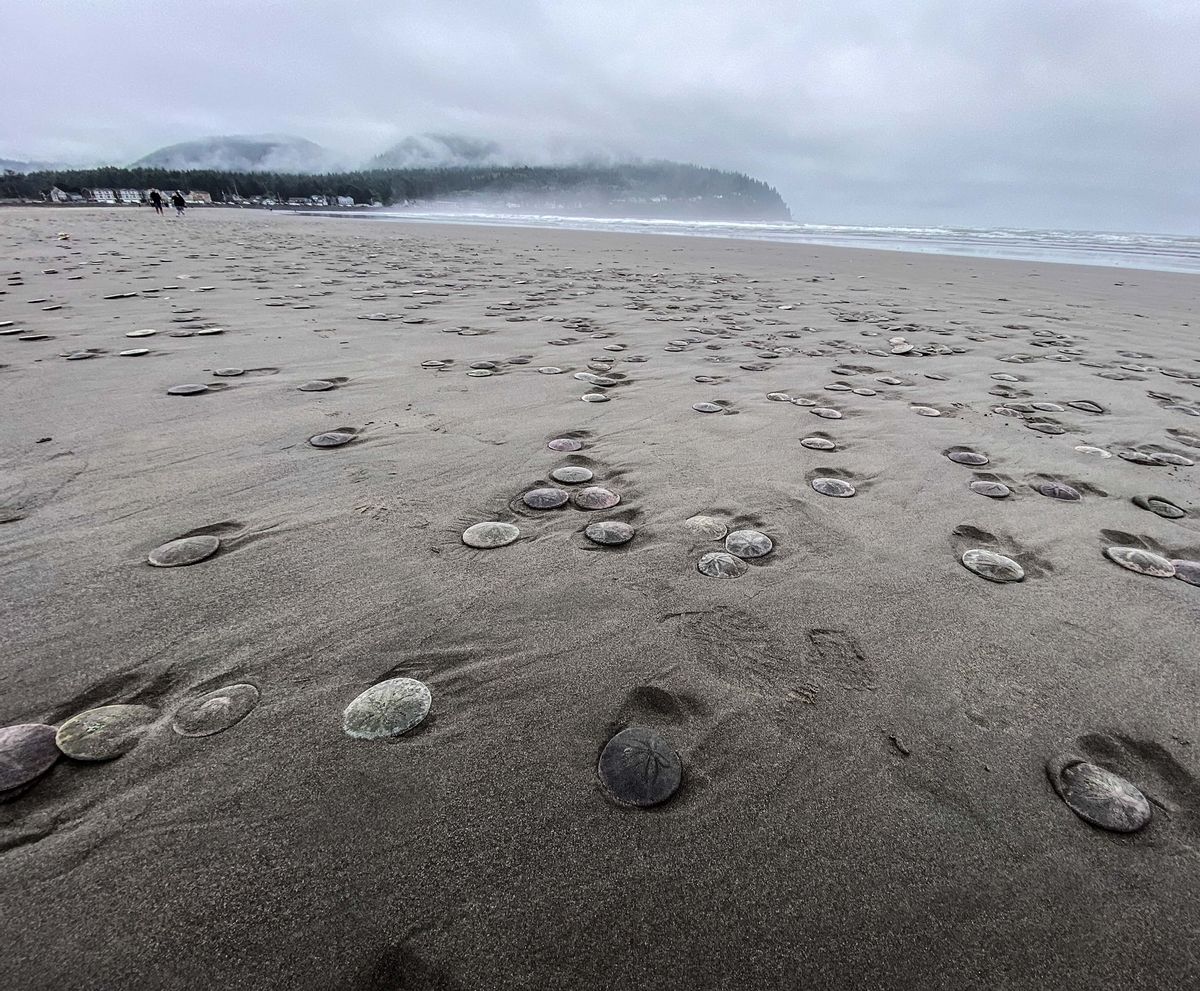Scientists were stumped in mid-August 2021 when thousands of sand dollars — small marine animals found around the world — mysteriously washed ashore along the northern Oregon coast.
News of the mass stranding event went viral after Oregon’s Seaside Aquarium shared photos on Facebook on Aug. 15, reported by local news outlets like The Oregonian and Oregon Public Broadcasting as well as international publications like The Daily Mail and Yahoo News.
“It appears that they are washing in during the afternoon high tides and getting stranding [sic] along the high tide line. They are still alive when stranded but are unable to make it back to the water once the tide recedes,” wrote the aquarium, resulting in the invertebrates “drying up and dying.”
“At this time, we do not know what has caused this, and these types of incidents usually have several contributing factors. We are also unaware if this is an isolated incident or if this is happing on other beaches,” wrote the aquarium.
https://www.youtube.com/watch?v=YVBSrlgQ1no
The Monterey Bay Aquarium refers to sand dollars as “flattened sea urchins,” and indeed, these plankton-devouring invertebrates are closely related to their spiny cousins. Scientifically known as Dendraster excentricus, the exterior of the Pacific species' calcium carbonate shell is covered in millions of hair-like spines known as “cilia” that help them move across the seafloor. A sand dollar is alive when these purple or green-hued cilia are present, but a bleached-out white coloring void of the fuzzy spines means that the animal has died.
What Caused the Die-Off?
Snopes spoke with Christina Piotrowski, collections manager of invertebrate zoology at the California Academy of Sciences, who said that without information on current offshore water conditions, it is difficult to determine exactly what contributed to the mass die-off. But she did offer up some theories.
“Typically inhabiting sandy habitats fairly close to the shoreline, although they can live in deeper waters, D. excentricus beds are inherently susceptible to both localized land-based activity and large-scale oceanic conditions,” explained Piotrowski.
“In addition to potentially being displaced from their beds by bottom trawl fishing activities, natural environmental conditions such as extreme storm surge and high wave action, stronger than usual currents, localized lowered water salinity, or dramatic increases in seawater temperatures near their sandy habitats could all be potential causes, or there could be some other localized disturbance that we're not aware of.”
Because they live in the sand directly on the seabed, sand dollars are also believed to be more susceptible to anoxic seafloor conditions brought on by large algal blooms that deprive the surrounding water of oxygen.
“However, any of these conditions or a combination of them could conceivably cause displacement of sand dollars from their beds and result in their washing ashore en masse,” added Piotrowski.
Previous Mass Stranding Events
While it may be the only mass stranding event in recent years to have hit the U.S. West Coast, it’s not the first time live urchins have washed ashore in mass numbers. Thousands of quarter-sized juvenile sand dollars washed up along parts of southwestern Florida in July 2016 in what local experts believed to have been due to natural causes. It was a particularly large spawning year that meant, in turn, a larger than normal die-off of recently spawned invertebrates that didn’t make it to adulthood.
What’s perplexing about the Oregon die-off is that many of the sand dollars appear to be sexually mature or adult individuals, which suggests that perhaps the event was caused by something out of the ordinary cycle.
Scientists suspect that some species of sand dollars could be impacted by ocean water acidification, but Piotrowski says that such events are unlikely to be related to the 2021 die-off. As of this writing, shellfish fisheries and beaches along the southern coast of Washington State were closed due to marine biotoxins likely caused by harmful phytoplankton.
A study published in early 2021 found that the warm water "blob" in the Pacific Ocean had resulted in a subsequent increase in toxic marine algal blooms from southern Oregon to California — and these harmful algal blooms were determined to be the culprit responsible for a massive marine wildlife die-off events across the west coast in 2011.
“This is only one possibility for what's recently happened in the sand dollar beds off Seaside and I'm afraid that without further study of local sea conditions we won't be able to know what happened,” said Piotrowski.
Harmful bacteria blooms are usually caused by agricultural or chemical runoff from nearby rivers. Just like terrestrial plants grow exponentially when fertilized, marine plants known as phytoplankton can see large blooms when fertilizer enters their water systems. And with the nearby Columbia River, sewers, septic systems, and livestock animal contamination of freshwater that flows seaward, such an event is entirely possible.
A variety of fish feed on D. excentricus, from starry flounder and California sheepshead to surf perch and sea stars. Because sand dollars eat dead organic matter in the water column, or detritus, they play a significant role in the marine environment.
“D. excentricus vacuums up algae and zooplankton from the water column above sandy subtidal habitats and eats small crustaceans and their larvae, thereby influencing their abundance and distributions. They also act to clean up organic debris from the seafloor,” said Piotrowski. “They not only process organic matter along the seafloor, but also act as primary predators of zooplankton, and grazers on algae and diatoms.”
And because the lifespan of sand dollars is thought to be around 10 years, regular die-offs could mean that local populations may be unable to rebound into reproductively mature populations. Therefore, it is critical for experts to document and monitor events like this to determine their cause and frequency.
Fun Fact: Young individuals of D. excentricus will often eat sand particles, especially heavy particles containing iron, for use as ballast to steady them in the sand against strong currents.
